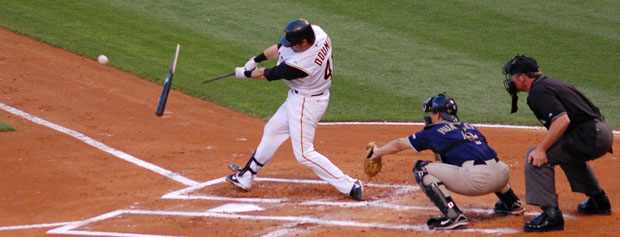
Another “home run” from the Forest Products Laboratory in Madison, Wisconsin. Did you know that Aldo Leopold was the Assistant Director of the Forest Products Laboratory. If you’re interested, check out this video on FPL history, or browse their website here. If you want to know about wood you can probably find something of interest in their general interest publications here.
Link to the Discover story here.
In April 2008, a jagged projectile of maple wood hurtled into the stands at Dodger Stadium in Los Angeles and struck Susan Rhodes in the face. She left the ballpark with a concussion and a broken jaw. By June, Major League Baseball (MLB) had commissioned a $500,000 investigation into the alarming number of bats that had shattered that season, including more than 750 in just three months.
Fans attending the 2011 World Series should be relatively safe from impalement, owing to some sharp scientific sleuthing that has reduced the number of pulverized bats in the league by 50 percent and shed light on one of baseball’s strangest mysteries.
In their 50-page report to MLB, the researchers, led by U.S. Forest Service engineer Dave Kretschmann, pinned blame squarely on two culprits: the type of wood (maple) and the cut of the grain. The conspicuous spike in shattered sticks, they discovered, coincided with a shift in preference from traditional ash bats to maple, a supposedly more durable wood that skyrocketed in popularity after Barry Bonds clobbered a record-breaking 73 home runs with maple bats in 2001. The researchers also found that in some bats the wood fibers ran along the handle at an angle, instead of straight up; parallel fibers create a solid foundation to absorb the force of the ball. Angled fibers are easy to spot in ash but are nearly invisible in maple, so manufacturers were unknowingly distributing bats that were sapped of up to three-quarters of their potential strength (although Bonds did not seem to notice). “That’s the problem you have when you make something with wood,” Kretschmann says. “There are so many variables.”
MLB has since mandated that bat manufacturers place an inkblot on the handle of every maple bat they make. The ink bleeds along the grain of the wood, allowing a third-party agency contracted by the league to ensure that the fibers run at an angle of no more than 3 degrees from vertical. As a result, the number of splintered bats plunged by 30 percent in 2009 and continued a steady descent last season. For Kretschmann, watching baseball has never been more satisfying: “On a high-definition TV I can see the little black inkblots and say, ‘Oh, I was involved in that.’ ”